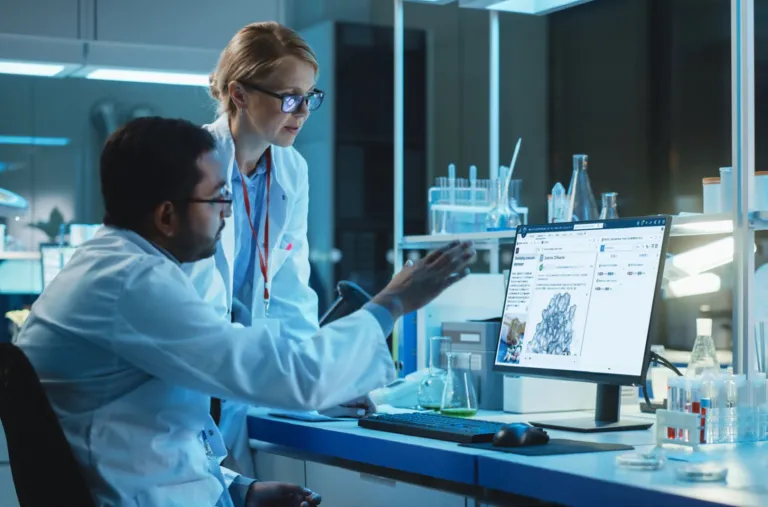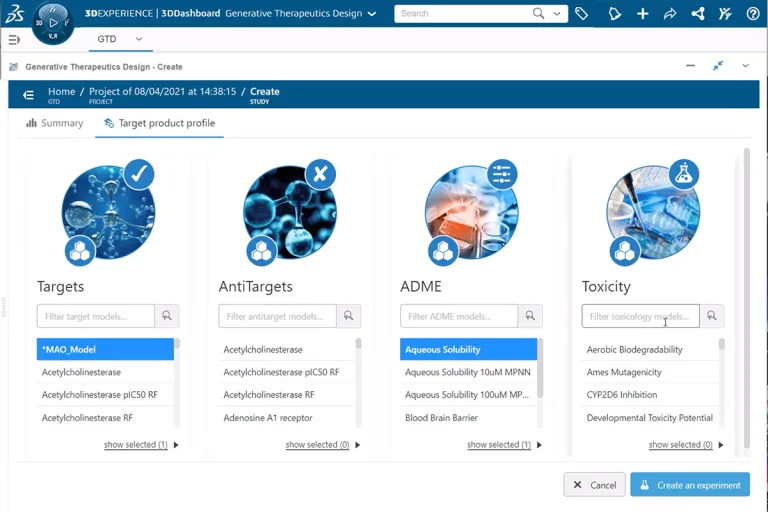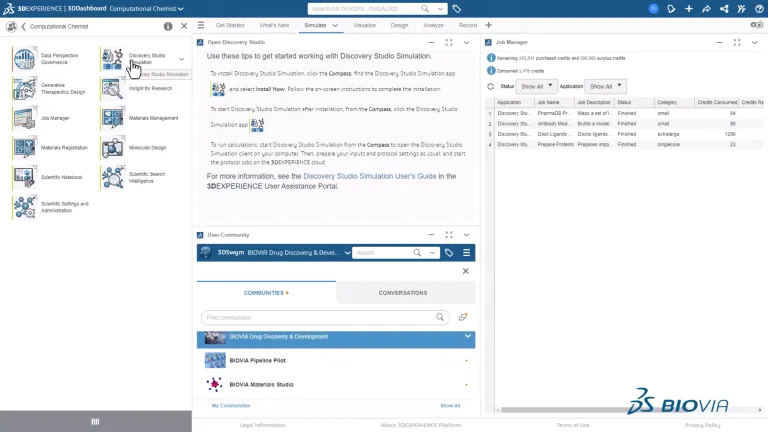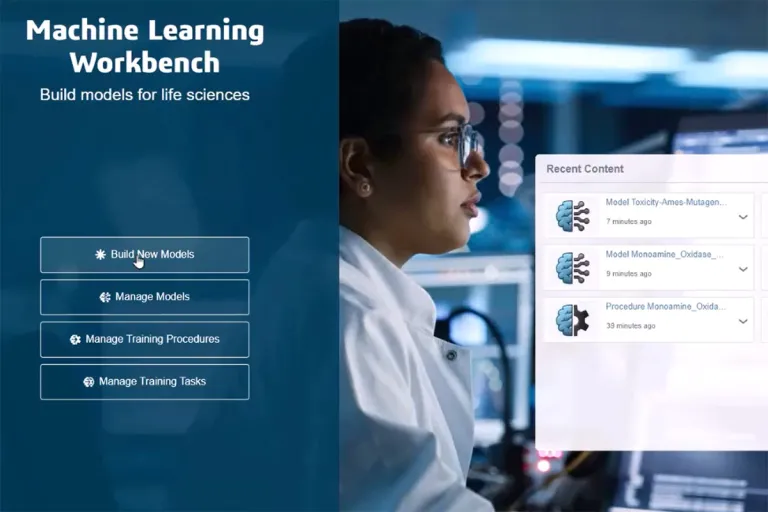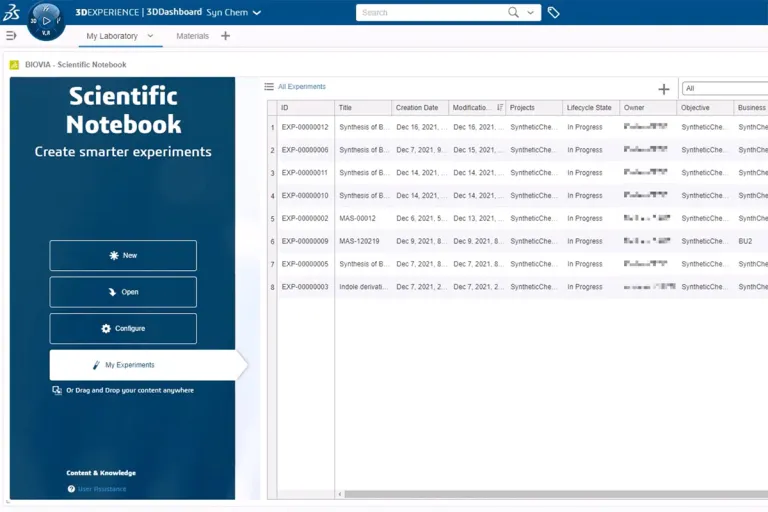Small Molecule Therapeutics Design
The Only Solution that Combines AI/Machine Learning, Physics-based 3D Molecular Modeling and Lab Informatics in a Single Environment
Identify High-Quality Small Molecule Drugs Faster
Drug discovery requires a multidisciplinary approach. BIOVIA’s end-to-end integrated solutions for Small Molecule Therapeutics Design are built over 30 years of expertise in research informatics, physics-based molecular modeling and simulation, and lab informatics. They facilitate collaboration across multidisciplinary research teams to design, discover and develop small molecule drugs faster at reduced costs.
One Platform: Flexible, Scalable and Extensible Solutions on Cloud
BIOVIA's solutions for Small Molecule Therapeutics Design are available as Software-as-a-Service (SaaS) applications, seamlessly integrated on the 3DEXPERIENCE platform. They can accommodate the research needs of both small teams and large pharmaceutical organizations, with the ability to:
- Quickly deploy the newest solutions without hardware or IT investment
- Customize data-driven workflows focused on unique requirements of individual research projects
- Incorporate unique custom or third-party models, algorithms, and data sources.
Highly Accurate Predictive Modeling with Active Learning Cycles
BIOVIA streamlines drug discovery by seamless integration of virtual lead identification and optimization methods with your own experimental design/testing in the lab:
- Make predictions on “what to make next” using “active learning”
- Democratize access to predictive models for increased efficiency
- Ensure data integrity, security, traceability, and consistency throughout the drug development lifecycle.
State-of the-art Science with AI and Machine Learning
- AI-driven Drug Design
- Modeling and Simulation
- Model Building
Reduce expensive real-world testing with generative AI
BIOVIA Generative Therapeutics Design (GTD) automates the virtual creation, testing and selection of novel small molecules with generative AI to design. It improves lead quality using multiparameter optimization (MPO) strategies that simultaneously address complex target product profiles (TPPs).
Researchers use this intuitive AI-based workflow to shorten development timelines, discover obscured insights, explore chemical space and save millions of research dollars per program. GTD is the only commercial-grade software designed to empower computational and medicinal chemists with AI for small molecule drug development.
Combine AI and physics-based modeling for drug discovery
BIOVIA Discovery Studio Simulation allows molecular modelers to build 3D pharmacophore and docking models, which then can used in BIOVIA Generative Therapeutics Design for enhancing the quality of the lead compounds. Users also have access to the premier high throughput docking algorithm GOLD from the Cambridge Crystallographic Data Centre (CCDC) with no additional license requirement.
Discovery Studio Simulation now includes OpenFold/AlphaFold AI models for structure prediction, in addition to validated physics-based, long-validated homology modeling algorithm MODELER.
Build ML models easily, with your own lab data
Providing an easy to use, interactive user interface, BIOVIA Machine Learning Workbench facilitates high-quality model building for researchers with little or no data science background. These models are then used in BIOVIA Generative Therapeutics Design experiments to optimize lead compounds.
Orchestration of model training on a recurrent basis or when new data becomes available helps identify the best drug candidates, leveraging all assay data for improved predictive modeling.
Harnessing the Power of AI-Ready Data
- Data Insights
- Connected Data
Gain Insights from Data
Make fast, informed decisions on which compounds to synthesize for testing.
With BIOVIA Insight, scientists can visualize, analyze, and browse molecular data proposed by Generative Therapeutics Design in detail, together with calculated properties and experimentally derived data, and can compare chemical structures, properties or other custom visualizations, while collaborating seamlessly with other team members.
Connect to Real World Data
BIOVIA Scientific Notebook and BIOVIA Materials Registration help improve efficiency and team productivity by leveraging existing knowledge, universal representation of materials, and bridging the gap between discovery and downstream activities.
They support many steps in Small Molecule Therapeutics Design, including:
- The planning of experiments
- The registration of virtual compound ideas
- The capture of chemical reactions and synthesized compounds as lots
- Determining whether the virtually designed compounds already exist as real compounds in team’s inventory
Start Your Journey
The world of Small Molecule Therapeutics Design is changing. Discover how to stay a step ahead with BIOVIA
FAQ About Small Molecule Drugs
Learn What BIOVIA Can Do for You
Speak with a BIOVIA expert to learn how our solutions enable seamless collaboration and sustainable innovation at organizations of every size.
Get Started
Courses and classes are available for students, academia, professionals and companies. Find the right BIOVIA training for you.
Get Help
Find information on software & hardware certification, software downloads, user documentation, support contact and services offering


